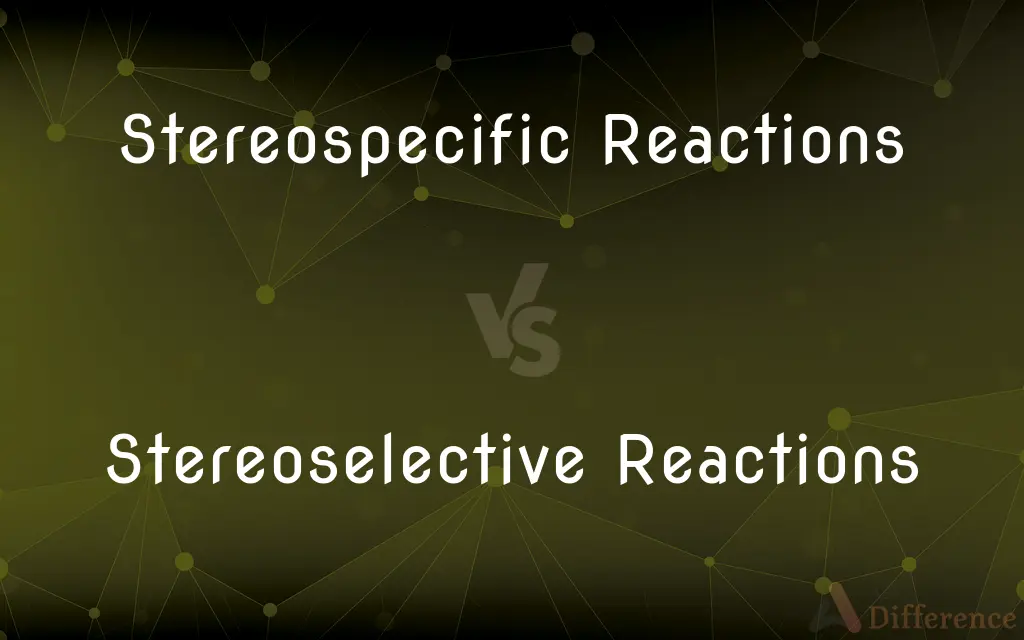Stereospecific Reactions vs. Stereoselective Reactions — What's the Difference?
Edited by Tayyaba Rehman — By Fiza Rafique — Published on December 2, 2023
Stereospecific Reactions involve a defined stereoisomer leading to a specific stereochemical outcome, while Stereoselective Reactions preferentially form one stereoisomer over another.

Difference Between Stereospecific Reactions and Stereoselective Reactions
Table of Contents
ADVERTISEMENT
Key Differences
In Stereospecific Reactions, a specific reactant stereoisomer undergoes transformation to produce a uniquely defined product stereoisomer. Conversely, in Stereoselective Reactions, multiple stereoisomers could be formed, but one is predominantly favored.
Stereospecific Reactions showcase a strict correlation between the stereochemistry of the reactant and that of the product. In contrast, Stereoselective Reactions show a preference in the formation of one stereoisomer over the other, though not strictly bound to a singular outcome.
Within Stereospecific Reactions, if the reactant's stereochemistry is changed, the product's stereochemistry will also change predictably. On the other hand, Stereoselective Reactions work more on probabilities, favoring the formation of one stereoisomer, but not exclusively producing it.
Stereospecific Reactions can be visualized as a lock and key mechanism, where only a specific key (reactant) gives a particular door (product). Stereoselective Reactions, however, can accept different keys (reactants) but have a preference for opening a certain door (product) more often.
Simply put, Stereospecific Reactions have a one-to-one relationship between reactant and product stereochemistry. In contrast, Stereoselective Reactions tend to favor the formation of one stereoisomer over others, without strict specificity.
ADVERTISEMENT
Comparison Chart
Outcome Predictability
Determined outcome based on reactant's stereochemistry.
Preferential, not strictly defined outcome.
Reactant-Product Relationship
Direct one-to-one stereochemical correlation.
No strict stereochemical correlation.
Exclusivity
Exclusive formation of a specific stereoisomer.
Predominant, but not exclusive, formation of an isomer.
Reactant Alteration Impact
Change in reactant stereochemistry leads to a changed product.
Preference remains, even if reactant is changed.
Conceptual Visualization
Lock and key mechanism.
Preference for a particular outcome, not exclusive.
Compare with Definitions
Stereospecific Reactions
Reactions with a defined stereochemical course.
The conversion of (Z)-alkene to (E)-alkene through certain reactions is stereospecific.
Stereoselective Reactions
Preferentially produce one stereoisomer over others.
Certain reactions yield predominantly the (R)-isomer over the (S)-isomer.
Stereospecific Reactions
Dictate a direct reactant to product stereochemistry.
In certain reactions, if you change the reactant's orientation, the product's orientation shifts predictably.
Stereoselective Reactions
Governed by probability rather than strict specificity.
The reaction environment favors the formation of one isomer, but other isomers might still form.
Stereospecific Reactions
Reliant on the reactant's specific stereochemistry.
Altering the reactant's stereochemical configuration drastically alters the product's form.
Stereoselective Reactions
Based on favorable pathways rather than determined courses.
Energetically favorable routes often lead to the major product in these reactions.
Stereospecific Reactions
Strictly produce a unique stereochemical outcome.
A particular chiral reactant will always yield a specific chiral product in these reactions.
Stereoselective Reactions
Yield a predominant, not exclusive, stereoisomer.
Even in reactions with a high stereoselectivity, trace amounts of other isomers can be detected.
Stereospecific Reactions
Always offer a consistent stereochemical transformation.
The reaction mechanism ensures a singular stereochemical path from start to finish.
Stereoselective Reactions
Not strictly tied to reactant's stereochemistry.
Regardless of subtle reactant changes, the reaction might still favor one product.
Common Curiosities
Can the outcome of Stereospecific Reactions be altered?
Yes, by changing the reactant's stereochemistry, the product's stereochemistry will also change.
Do Stereoselective Reactions always produce a single product?
No, Stereoselective Reactions preferentially produce one stereoisomer, but others can still form.
Are Stereospecific Reactions more predictable than Stereoselective ones?
Yes, Stereospecific Reactions have a one-to-one reactant to product stereochemical relationship.
What determines the predominant product in Stereoselective Reactions?
The reaction's conditions and mechanism favor the formation of one stereoisomer over others.
Can Stereoselective Reactions ever be 100% selective?
Ideally, yes, but in practice, there might always be a minor amount of the other stereoisomers.
Is the mechanism crucial for both Stereospecific and Stereoselective Reactions?
Yes, the mechanism defines the stereochemical course or preference of the reaction.
Can a reaction be both Stereospecific and Stereoselective?
It's unusual, as Stereospecific dictates a strict outcome, while Stereoselective indicates a preference.
What factors affect the outcome of Stereoselective Reactions?
Factors include reaction conditions, substrates, and the presence of chiral or achiral catalysts.
How are Stereospecific Reactions distinct in outcome?
Stereospecific Reactions have a determined stereochemical outcome based on the reactant's configuration.
Which type of reaction, Stereospecific or Stereoselective, is more common in nature?
Both types occur in nature, but the context determines which one is more prevalent.
Are Stereospecific Reactions always 100% specific?
Ideally, yes, but side reactions or impurities can sometimes produce other stereoisomers.
Can Stereoselective Reactions be manipulated to increase selectivity?
Yes, by optimizing conditions or using chiral catalysts, selectivity can often be improved.
What role do catalysts play in Stereospecific Reactions?
Catalysts can influence the reaction mechanism and thereby maintain the stereospecificity of the reaction.
Are enzymes in our body an example of Stereoselective agents?
Yes, enzymes often show stereoselectivity, favoring the formation of specific stereoisomers.
Are Stereospecific Reactions reversible?
Theoretically, yes. If reversed, they would also follow a stereospecific course.
Share Your Discovery

Previous Comparison
PCT vs. DCT
Next Comparison
HDMI vs. VGAAuthor Spotlight
Written by
Fiza RafiqueFiza Rafique is a skilled content writer at AskDifference.com, where she meticulously refines and enhances written pieces. Drawing from her vast editorial expertise, Fiza ensures clarity, accuracy, and precision in every article. Passionate about language, she continually seeks to elevate the quality of content for readers worldwide.
Edited by
Tayyaba RehmanTayyaba Rehman is a distinguished writer, currently serving as a primary contributor to askdifference.com. As a researcher in semantics and etymology, Tayyaba's passion for the complexity of languages and their distinctions has found a perfect home on the platform. Tayyaba delves into the intricacies of language, distinguishing between commonly confused words and phrases, thereby providing clarity for readers worldwide.
















































